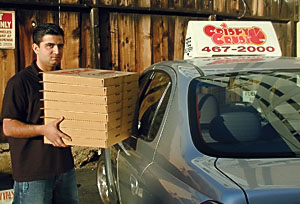 |
| Children's car seat, properly used. |
Washington is one of 14 states that require a child under the age of 13 be seated in the rear of a vehicle "where it is practical to do so", according to the Revised Code of Washington.
Not only are front-end crashes the most prevalent type of auto accident, the added threat posed by air bags, which are designed for adult passengers, makes the front seat a dangerous place for youngsters. Air bags can severely injure or even kill small children seated in the front seat, even in an approved car seat.
This is a disparity of opinion among drivers as to what should determine when a child can ride in the front seat. Nearly half the poll respondents said height should be the primary criteria, and another 21 percent believed that weight should be the determining factor. Only 25% of respondents agreed with the state age requirement that the age of 13 was the key factor.
According to the Insurance Institute for Highway Safety (IIHS), placing kids in back instead of in front reduces injury risk by 64 percent for infants and kids up to age 8, and 31 percent for children 9 to 12.
While age is the determining factor in where children should ride, height and weight are more important in deciding when a youngster is ready to move from a child safety seat to a booster seat, or just be restrained with a seat belt.
The general rule of thumb is that children under 40 pounds should be in a car seat. As kids outgrow the height and weight requirements of a car seat, the recommendation is that they first graduate to a booster seat that allows cross-body seat belts, then eventually to just using an adult seat belt.
Although car seats and booster seats can be inconvenient and expensive, the protection they provide for small children is vital. Besides, it's the law.
To learn more about the PEMCO Insurance Northwest Poll and view a summary of the results, visit www.pemco.com/poll, where the public is invited to participate in an informal version of the poll to see how their own responses compare with those collected by FBK Research of Seattle.
 |
| Child in booster seat. |
About the PEMCO Insurance Northwest Poll
PEMCO Insurance commissioned this independent survey that asked Washington drivers several questions about driving habits and attitudes toward current Northwest issues. The sample size, 826 respondents in Washington, yields an accuracy of +/- 3.5 percent at the 95 percent confidence level. In other words, if this study were conducted 100 times, in 95 instances the data will not vary by more than +/- 3.5 percent.
PEMCO Insurance commissioned this independent survey that asked Washington drivers several questions about driving habits and attitudes toward current Northwest issues. The sample size, 826 respondents in Washington, yields an accuracy of +/- 3.5 percent at the 95 percent confidence level. In other words, if this study were conducted 100 times, in 95 instances the data will not vary by more than +/- 3.5 percent.















